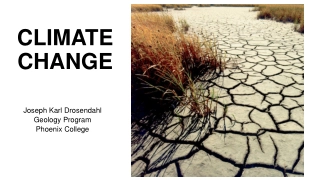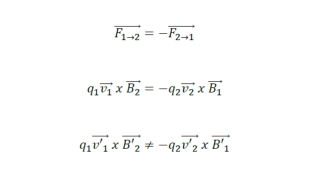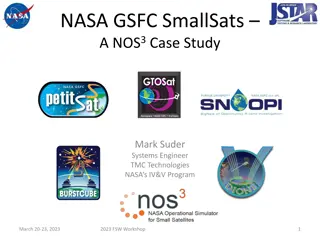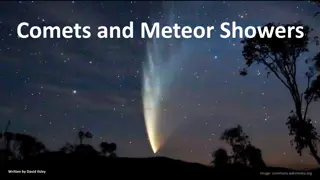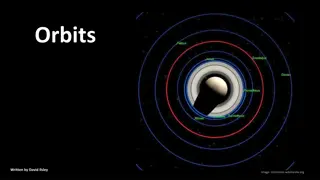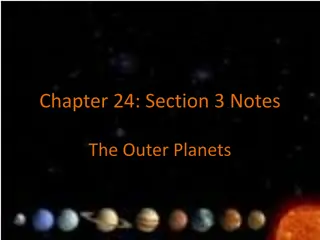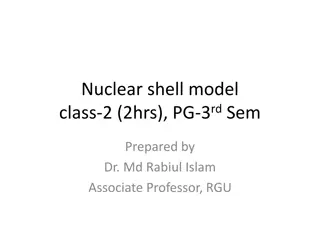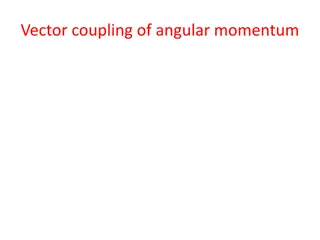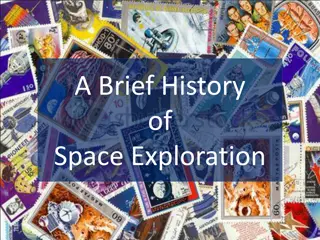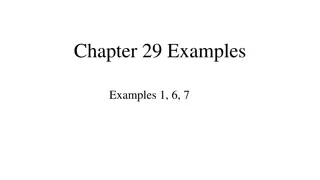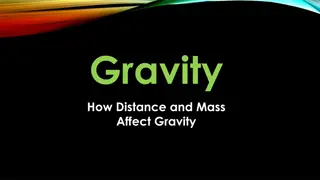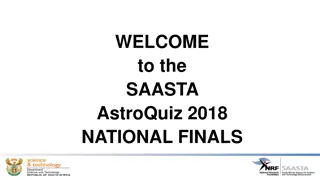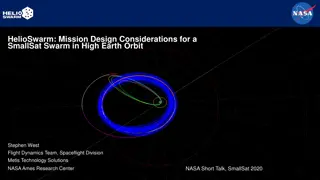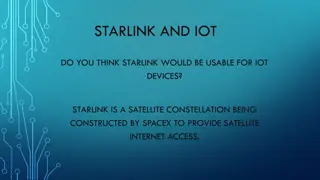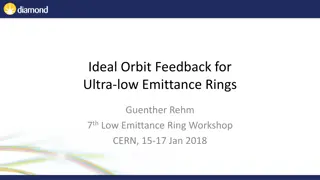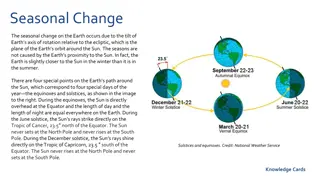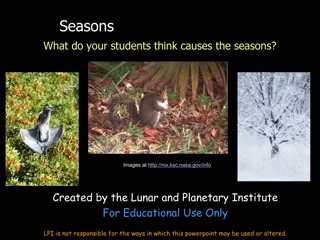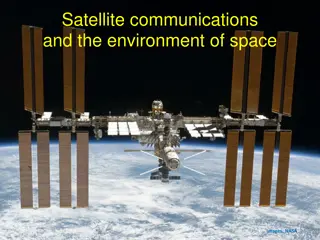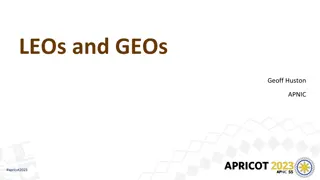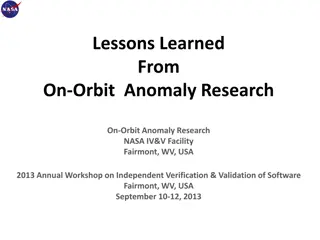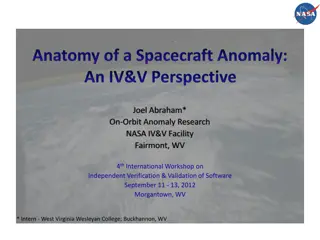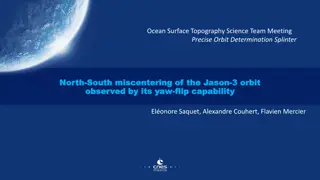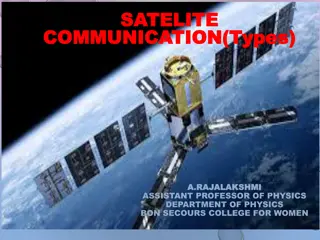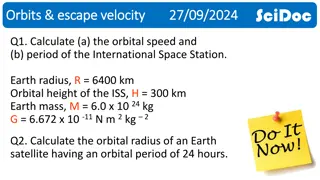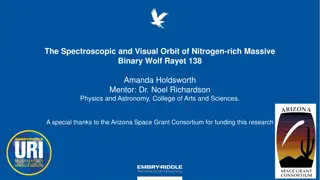Climate Change
Past and present factors affecting climate change, from natural phenomena like sun output and Earth's orbit to human activities. Delve into the potential causes such as greenhouse gases and meteor impacts.
71 views • 31 slides
Einstein's Achievements in Relativity and Postulates Explained Through Images
Explore Einstein's groundbreaking achievements in the theory of relativity, including the explanation of the precession of Mercury's orbit and gravitational lensing effects. Discover his postulates on the constancy of the speed of light and the distinctions between special and general relativity thr
3 views • 38 slides
Advancements in InSpace Production Applications and Manufacturing
Explore the latest developments in InSpace Production Applications (InSPA) and manufacturing in low Earth orbit, involving key figures from NASA and industry experts. Discover how microgravity can enhance materials and processes at the atomic level, leading to innovative advancements in technology a
0 views • 16 slides
Slide Orbit Presentation Slides Collection
Explore a stunning collection of presentation slides showcasing various designs and styles. Each slide offers a unique visual experience, perfect for enhancing your presentations with modern and captivating visuals.
2 views • 76 slides
Collection of Presentation Slides from Slide Orbit
A collection of visually appealing presentation slides featuring various designs and styles. Explore these high-quality images for inspiration and creativity in your own presentations.
3 views • 14 slides
NASA SmallSat Development: FSW Workshop Insights
Delve into NASA's SmallSat development through the eyes of systems engineers and software experts. Explore NOS3 architecture, virtual machines, and hardware platforms for Low Earth Orbit and Geosynchronous Equatorial Orbit buses. Gain valuable insights from the FSW Workshop sessions held in March 20
0 views • 14 slides
Autonomous Conjunction Assessment Methodology Among Satellites
Methodology for Collision Avoidance (CA) among constellations of autonomously-controlled satellites is crucial for protecting assets in space. From straightforward protection against dead satellites to active coordination for maneuverable payloads, the range of primary-secondary CA possibilities is
1 views • 12 slides
SpaceRadMon-NG: Revolutionizing Radiation Monitoring in Space Missions
The SpaceRadMon-NG is a cutting-edge radiation monitoring device designed for CubeSats, offering advanced capabilities for measuring Total Ionizing Dose (TID) and High Energy Hadrons (HEHs) fluence. Developed as a next-generation solution, it aims to enhance diagnostic and environmental monitoring i
4 views • 15 slides
CYGNSS Earth Venture Mission Overview
The CYGNSS Earth Venture Mission involves eight satellites in low Earth orbit designed to measure near-surface wind speed over oceans and map soil moisture and inland water under vegetation on land. Launched in December 2016, the mission has been successful, currently in its extended phase with seve
2 views • 9 slides
Understanding Atomic Configurations and Term Symbols
The energy of atomic configurations is determined by electrostatic attraction between electrons and the nucleus, electron-electron repulsion, spin-orbit coupling, and spin-spin interactions. Term symbols in electronic spectroscopy specify atomic states using quantum numbers. Hund's rule and the Paul
8 views • 12 slides
Understanding Eclipses: The Celestial Dance Between the Sun, Moon, and Earth
Eclipses are fascinating astronomical events where the Moon comes between the Sun and Earth, causing either a solar eclipse or lunar eclipse. This summary delves into the different types of eclipses, such as total and partial solar eclipses, the Moon's elliptical orbit, and the intricate movements t
4 views • 25 slides
Exploring Lunar Surface Radiation Risks and Mitigations Using Bioengineering
Lunar Explorer Instrument for space biology applications, LEIA Mission, addresses radiation health risks for crewed lunar exploration. The project aims to engineer yeast strains to study radiation sensitivity and identify genetic factors affecting cellular response. The instrument suite includes Bio
6 views • 8 slides
Comets and Meteor Showers
This informative article delves into the fascinating world of comets, from their icy origins to their various locations in the solar system, including the Kuiper Belt and Oort Clouds. Discover the different types of comets, their composition, and the vast distances they travel as they orbit the Sun.
3 views • 29 slides
Understanding Orbits and Gravity in Space
Explore the concept of orbits and gravity in space by following the trajectory of a satellite above Earth. Learn how gravity keeps the satellite in a perpetual state of orbit, moving at a constant speed parallel to the ground due to the Earth's round shape. Discover how varying speeds affect orbit s
0 views • 34 slides
Discovering Mercury: The Intriguing Innermost Planet of Our Solar System
Mercury, the closest planet to the Sun, is a fascinating world with unique characteristics. Despite being challenging to observe, Mercury shines brightly in the sky, boasting a coppery tinge and a temperature range from 193°C to 427°C. Its day is longer than its year, rotating 1.5 times each orbit
1 views • 21 slides
Exploring the Outer Planets: Jupiter and Saturn
Discover fascinating details about the outer planets Jupiter and Saturn, from Jupiter's gaseous composition and iconic Great Red Spot to Saturn's impressive rings and unique characteristics like being the "Ringed Planet." Explore the moons of Jupiter, including the Galilean Moons, and learn about Sa
0 views • 18 slides
Theoretical Derivation and Application of Nuclear Shell Model in Quantum Physics
The nuclear shell model, a fundamental concept in quantum physics, is explained in detail using Schrodinger wave equations and spherical coordinates. The model describes the behavior of nucleons in atomic nuclei based on energy values, quantum numbers, and shell closure principles. Spin-orbit intera
0 views • 14 slides
Theoretical Derivation and Application of Nuclear Shell Model in Quantum Physics
Brought to you by Dr. Md. Rabiul Islam, Associate Professor at RGU, this presentation delves into the theoretical derivation of the shell model using Schrodinger wave equations in the presence of specific potentials. Exploring the solutions for the wave equation and explaining the role of quantum nu
1 views • 14 slides
Understanding Angular Momentum in Quantum Mechanics
Exploring the concept of total angular momentum in quantum mechanics, which involves the quantization of orbital and spin angular momenta. The coupling of these vectors leads to the formation of total angular momentum, with implications for the behavior of single-electron systems like the hydrogen a
0 views • 16 slides
A Brief History of Space Exploration
Space exploration has seen significant milestones, from the German V2 rocket in 1942 to Yuri Gagarin becoming the first man in space in 1961 and the historic Apollo 11 moon landing in 1969. Animals like fruit flies and monkeys have ventured into space, contributing to scientific understanding. Russi
2 views • 14 slides
Collection of Various Images - Slide Orbit
This content features a collection of images including a rat, rabbit, rose, red, room, rocket, dress, ran, rest, rap, trap, trip, and crack. Each image provides a detailed description and is showcased with a width of 900px on Slide Orbit.
0 views • 14 slides
Magnetic Force and Acceleration of Electrons in Television Picture Tubes
An electron in a television picture tube is analyzed as it moves towards the front of the tube in a magnetic field. The magnetic force and acceleration of the electron are calculated, along with determining the linear speed of a proton moving in a circular orbit under a magnetic field. Additionally,
0 views • 6 slides
Understanding Gravity: The Impact of Distance and Mass
Objects with mass exert gravitational force, influencing each other based on mass and distance. Gravity, a fundamental force, keeps objects like Earth and the moon in orbit and affects how objects fall towards each other. The relationship between distance and gravity is crucial, affecting the streng
0 views • 12 slides
SAASTA AstroQuiz 2018 National Finals - Lunar Eclipse Questions
The SAASTA AstroQuiz 2018 National Finals feature a series of questions related to lunar eclipses, moon characteristics, and celestial bodies. Participants must answer questions about the longest lunar eclipse of the 21st century, the color of the moon during an eclipse, and the relationship between
0 views • 54 slides
Mission Design Considerations for a SmallSat Swarm in High Earth Orbit
HelioSwarm presents a mission concept involving a propulsive ESPA hub deploying smallsat nodes in a lunar resonant orbit. The swarm design requirements focus on complex hub-relative trajectories for each node, emphasizing high-rate data crosslinks and measurement-optimized tetrahedra formation. Smal
6 views • 7 slides
Starlink's Potential for IoT Devices Explained
Starlink, the satellite constellation by SpaceX, holds promise for IoT connectivity with its thousands of small satellites in low Earth orbit. The directional antennas required may impact IoT device adoption. However, the global coverage offered by Starlink could revolutionize IoT connectivity in re
1 views • 8 slides
Ideal Orbit Feedback for Ultra-low Emittance Rings Workshop Summary
The workshop on Ideal Orbit Feedback for Ultra-low Emittance Rings by Guenther Rehm at CERN in January 2018 covered topics such as Orbit Feedback Motivation, Bandwidth, Latency, Control Techniques, and References for further reading. The presentation highlighted the importance of precise beam positi
1 views • 27 slides
Understanding the Impact of Seasonal Changes on Solar Energy Utilization
The Earth's tilt causes seasonal changes, affecting the Sun's path and daylight length. Solstices and equinoxes mark key points in the Earth's orbit. The Sun's path dictates daylight duration and solar radiation intensity, crucial for solar energy systems. Variations in daytime length influence sola
1 views • 4 slides
Exploring the Causes of Seasons Through Data and Models
Explore the concept of seasons through data analysis of average daily temperatures in tourist cities, observations using planetarium software, true color images of Earth's changes through the seasons, and hands-on modeling activities. Discover how the tilt of the Earth's axis and its orbit around th
0 views • 19 slides
Exploring Satellite Orbits and Space Missions
This content covers a variety of topics related to satellites, including geosynchronous orbit, satellite history, organisms sent to orbit, types of orbits, orbital altitudes, and current satellite usage. It delves into the history of satellite launches, types of orbits, and the functions of satellit
0 views • 20 slides
Investigating FUNcube Satellite and Space Environment
FUNcube satellite, a small satellite equipped with solar panels, batteries, and communication antennas, operates above Earth's atmosphere to collect and relay data through radio communication. By analyzing the telemetry graphs produced by the satellite, tasks include determining the time taken for o
0 views • 9 slides
Understanding Orbital Altitudes and Satellite Services
Explore the fascinating realm of orbital altitudes and satellite services, including the differences between Low Earth Orbit (LEO) and Geostationary Earth Orbit (GEO). Learn about the physics behind satellite trajectories and how services like Starlink and Skymuster provide unique communication solu
0 views • 35 slides
Lessons Learned from On-Orbit Anomaly Research
The On-Orbit Anomaly Research workshop held at the NASA IV&V Facility in 2013 focused on studying post-launch anomalies and enhancing IV&V processes. The presentations highlighted common themes like Pseudo-Software Command Scripts, Software and Hardware Interface issues, Communication Protocols, and
0 views • 55 slides
On-Orbit Anomaly Research at NASA: Causes and Solutions
On-Orbit Anomaly Research (OOAR) at NASA's IV&V Facility involves studying mishaps related to space missions, identifying anomalies, and improving IV&V processes. The research delves into the causes of anomalies, such as operating system faults, and proximate causes like software deficiencies. Detai
0 views • 20 slides
Analysis of Magnet Errors in CEPC and LEP: Impact on Accelerator Performance
Investigating the effects of magnet errors on the Double Arc (DA) in the CEPC partial double ring, including alignment parameters, field errors, and their consequences on the orbit, tune, and stability of the beam. The study explores quadrupole, bending magnet, and sextupole field errors, highlighti
0 views • 13 slides
Ocean Surface Topography Science Team Meeting on Precise Orbit Determination
The Ocean Surface Topography Science Team Meeting delved into the precise orbit determination of the Jason-3 satellite, focusing on miscentering observations and the benefits of yaw flips. The meeting discussed previous approaches, the context of the satellite's orientation, goals for monitoring per
0 views • 12 slides
Satellite System Design Considerations and Applications
Satellite system design involves various technical considerations such as optimal modulation, coding schemes, and service types. Positioning satellites in orbit faces challenges like frequency and orbit selection. Satellite limitations include high initial investments and spectrum crowding. However,
0 views • 32 slides
Understanding Different Types of Satellite Communication Orbits
Explore the various types of satellite communication orbits, including Geostationary Earth Orbit (GEO), Low Earth Orbit (LEO), Medium Earth Orbit (MEO), and Highly Earth Orbit (HEO). Learn about the advantages and disadvantages of each orbit in relation to satellite communication technologies.
0 views • 8 slides
Orbital Mechanics and Satellites Overview
This content provides calculations for the orbital speed and period of the International Space Station, as well as the orbital radius of an Earth satellite with a 24-hour period. It explains the concept of artificial satellites, different types of orbits such as Low Earth Orbit (LEO), Medium Earth O
0 views • 17 slides
Studying Wolf-Rayet Stars: The Spectroscopic and Visual Orbit of WR 138
Wolf-Rayet (WR) stars are evolved, massive stars with their outer hydrogen envelopes stripped away, leading to strong stellar winds. Understanding these nitrogen-rich, carbon-rich, and oxygen-rich WR stars is crucial in unraveling their formation and contribution to nebula creation. This research de
0 views • 10 slides
